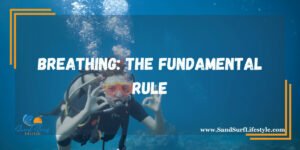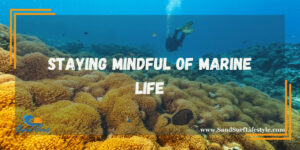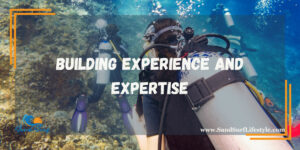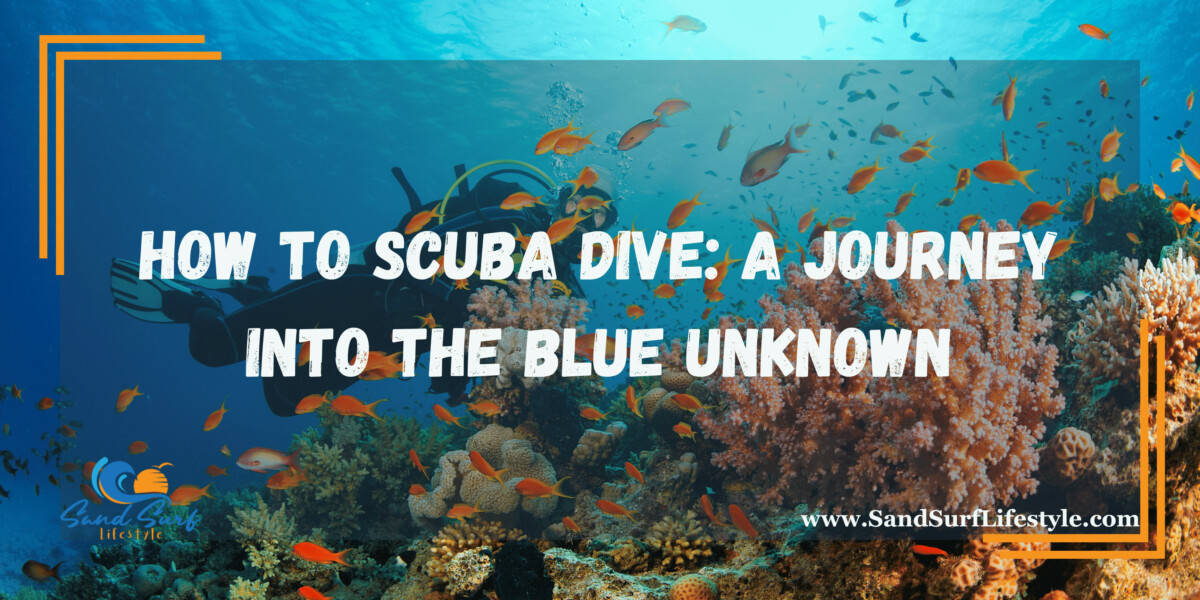Scuba diving is a captivating activity that allows us to explore the mesmerizing depths of the ocean, encountering marine life in their natural habitats. While the idea of breathing underwater might seem daunting, mastering the art of scuba diving opens up a world of wonder and excitement.
Breathing: The Fundamental Rule

Maintaining a consistent and uninterrupted breathing rhythm is an essential principle in scuba diving that cannot be overstated. The phrase “breathe continuously while on scuba” encapsulates a golden rule that must become second nature to every diver. The reason behind this rule is grounded in the physiological mechanics of our respiratory system and the dynamics of underwater pressure.
The admonition to “never hold your breath underwater” carries crucial importance. When we submerge ourselves, the pressure of the surrounding water increases with depth. Holding one’s breath while ascending or descending underwater can have dire consequences. As a diver ascends, the reduction in pressure causes the air inside the lungs to expand. Conversely, descending causes air to compress. These rapid fluctuations in air volume can lead to lung barotrauma—a serious injury resulting from the overexpansion or contraction of the lungs.
By adhering to the guidance of breathing steadily and naturally from the regulator, divers ensure a continuous flow of life-sustaining oxygen to their lungs. This not only prevents the risk of lung injuries but also maintains buoyancy control. When a diver inhales from the regulator, air enters the lungs, creating positive buoyancy. Exhaling releases the air, reducing buoyancy. This controlled exchange of air aids in maintaining an optimal depth and balance in the water.
The simple instruction to “breathe continuously while on scuba” encompasses a profound understanding of the physical dynamics involved in diving. It is a reminder that the underwater environment demands respect and adherence to specific guidelines to ensure the safety and enjoyment of this extraordinary activity. Divers who internalize this rule and breathe effortlessly through their regulators embark on underwater journeys with a heightened sense of awareness, allowing them to fully immerse themselves in the mesmerizing wonders of the aquatic realm.
To learn about the path to becoming a certified scuba diver, check out this article.
Equalization: A Delicate Balancing Act
Equalizing your ears and sinuses during descent is an imperative technique for divers to comprehend and execute diligently. As you venture into the depths of the underwater world, the pressure exerted by the surrounding water increases, creating a significant variation in pressure between the environment and your internal air spaces. Neglecting to address this pressure difference can result in discomfort, pain, and even potential ear injuries.
The phrase “equalizing your ears and sinuses early and often during your descent” underscores the urgency and frequency with which this practice must be undertaken. The Eustachian tubes, responsible for equalizing pressure in the middle ear, play a pivotal role in this process. As you descend, the increased water pressure can cause these tubes to close, trapping air inside the middle ear. This imbalance of pressure can lead to barotrauma, a condition that manifests as pain or a feeling of fullness in the ears.
The technique of equalization involves a simple yet effective procedure. By gently pinching your nose and exhaling softly, you create a controlled release of air through the Eustachian tubes. This action equalizes the pressure inside your ears with the pressure in the surrounding water, preventing discomfort and potential injuries. Regularly repeating this process—early in the descent and at regular intervals—ensures that pressure differences are constantly managed, allowing you to descend comfortably and without risk.
Equalization serves as a reminder of the intricacies of our body’s response to changing pressure environments. By acknowledging the significance of equalizing your ears and sinuses, you demonstrate a profound understanding of the connection between physiological responses and the environment you’re navigating. Embracing this practice safeguards against discomfort fosters an enhanced diving experience, and reinforces the importance of maintaining a harmonious equilibrium between the underwater world and the human body.
Safe Ascents and Monitoring
Ascending slowly after each dive is not just a guideline; it’s a vital practice that safeguards divers against a potentially debilitating condition: decompression sickness, colloquially known as “the bends.” This condition arises when dissolved nitrogen in your body’s tissues forms bubbles due to rapid pressure changes during ascents. These bubbles can obstruct blood vessels, causing pain, joint stiffness, and even severe neurological complications.
The instruction to “make safety stops during your ascent” holds immense significance. Safety stops involve pausing at specific depths for a prescribed duration, allowing excess nitrogen to be released gradually from your body. This controlled release mitigates the risk of bubble formation and enables your body to return to surface pressure safely.
Additionally, continuous monitoring of your dive parameters is a non-negotiable aspect of safe diving practices. Your depth, dive time, and pressure gauge are like your lifelines underwater. Monitoring these variables ensures you stay within safe diving limits, preventing issues like nitrogen buildup and oxygen toxicity. By adhering to these practices, you demonstrate a profound understanding of the delicate interplay between the human body and the underwater environment, prioritizing your well-being and enhancing your diving experience.
Buoyancy Control and Weight Distribution
Imagine the sensation of gliding underwater, akin to a fish gracefully navigating its habitat. This sensation can be achieved through two critical elements: buoyancy control and proper weight distribution. Mastering these aspects is akin to unlocking the art of underwater movement.
The caution against “overloading yourself with weights” highlights the significance of achieving neutral buoyancy. Excessive weights hinder your ability to remain neutrally buoyant, making it difficult to maintain a controlled depth and move efficiently. Collaborating with your instructor to find the optimal weight setup for your body and equipment is essential. This setup enables you to hover effortlessly in the water, a feeling that epitomizes the elegance of underwater exploration.
Buoyancy control extends beyond mere weight adjustments. It involves finesse in manipulating your buoyancy control device (BCD), using small bursts of air to ascend and controlled exhalations to descend. The art of buoyancy control takes time to master but transforms your diving experience into a seamless and fluid interaction with the aquatic world.
By grasping the intricacies of buoyancy control and weight distribution, you become attuned to the underwater environment’s dynamics. This awareness not only enhances your comfort but also minimizes your impact on fragile ecosystems. As you glide through the water with the poise of a fish, you embrace the essence of responsible diving and contribute to the preservation of the underwater realm.
Navigation and Communication
Navigating underwater offers a sense of exploration and adventure, but it’s a skill that demands careful attention and preparation. The phrase “familiarise yourself with underwater landmarks and use a compass for orientation” emphasizes the need for orientation tools and knowledge of your surroundings. Underwater landmarks such as rock formations, coral formations, and distinct features aid in maintaining your bearings. A compass serves as your steadfast guide, ensuring you navigate in the intended direction.
However, successful navigation is not a solo endeavor. The direction “maintain a communication system with your dive buddy” underscores the importance of clear communication underwater. Using a series of hand signals, divers can share valuable information such as changes in direction, alerts for potential hazards, or even express excitement about spotting unique marine life. This non-verbal communication not only enhances safety but also enriches the shared experience of exploring underwater wonders.
Staying Mindful of Marine Life

When it comes to diving, fostering a respectful relationship with marine life is a cornerstone of ethical diving practices. The directive to “maintain a safe distance from marine creatures, never touching or disturbing them” embodies this ethos. Marine creatures thrive in their natural habitats, and interfering with them can disrupt delicate ecosystems and cause stress to the animals.
The philosophy of “take only photographs and leave only bubbles” encapsulates the principle of responsible diving. By refraining from collecting or disturbing marine life and leaving no physical trace behind, divers help maintain the fragile equilibrium of aquatic environments. This commitment extends beyond individual dives; it contributes to the preservation of underwater ecosystems for future generations of divers and marine enthusiasts.
By adhering to these mindful practices, divers become stewards of the underwater realm, promoting conservation and demonstrating respect for the beauty and complexity of marine life. Through ethical diving, you partake in an enriching experience that transcends mere observation, fostering a deep connection with the underwater world while actively contributing to its protection.
Emergency Preparedness and First Aid
While underwater emergencies are rare, being prepared to handle them is paramount. The instruction to “enroll in a comprehensive scuba diving certification course that includes training in emergency protocols and first aid techniques specific to diving” underlines the significance of proactive readiness. Divers must equip themselves with the knowledge and skills required to respond effectively to unexpected situations.
Participating in a certified course not only imparts critical emergency protocols but also instills confidence in divers to manage unforeseen events. Acquiring expertise in underwater first aid ensures you can administer aid promptly, minimizing risks and promoting safety.
Additionally, “equipping yourself with a diving-specific first aid kit” signifies proactive planning. Such kits are tailored to diving-related emergencies and contain items like wound dressings, pressure dressings, and specialized tools. Understanding how to utilize these resources efficiently is vital, as it can make a crucial difference in emergencies.
Proper Equipment Care and Maintenance
Your diving equipment is your lifeline beneath the waves, and its reliability is non-negotiable. The emphasis on “regular maintenance and proper care” highlights the responsibility divers bear in safeguarding their gear. Post-dive, thoroughly rinsing equipment with fresh water combats salt and debris buildup that can compromise performance and durability.
Storing gear in a “cool, dry place away from direct sunlight” is not merely a precaution; it extends the lifespan of your equipment. Exposure to harsh conditions can cause degradation and corrosion.
Following “manufacturer guidelines for servicing and inspecting your gear” aligns with responsible ownership. Regular servicing ensures equipment functions optimally, reducing the risk of malfunction. By maintaining gear to high standards, divers exhibit a commitment to their safety and overall diving experience.
Building Experience and Expertise

Scuba diving is an evolving skill that flourishes with experience. The directive to “consider taking advanced diving courses” embodies a commitment to ongoing learning. Advanced courses not only enhance proficiency but also open doors to diverse dive sites and experiences.
Participation in “underwater clean-up initiatives or marine conservation projects” manifests a dedication to environmental stewardship. It’s a testament to divers’ appreciation for the oceans that provide them with exhilarating adventures.
Through these continuous efforts, divers elevate their expertise, foster a deeper bond with the underwater world, and contribute positively to the conservation of marine ecosystems. As they navigate their underwater journey, they remain cognizant of their role as guardians of the aquatic realm.
To learn about the deepest you can scuba dive, check out this article.
Conclusion
Scuba diving is a rewarding adventure that allows you to connect with the beauty of the underwater world. By adhering to these essential principles—breathing continuously, equalizing regularly, monitoring your depth and time, maintaining buoyancy, respecting marine life, and being prepared for emergencies—you can ensure a safe and enjoyable diving experience. Embrace the opportunity to dive like a fish and immerse yourself in the awe-inspiring wonders that lie beneath the waves.
Please note that the contents of this blog are for informational and entertainment purposes only and should not be construed as legal advice. Any action taken based on the information provided in this blog is solely at your own risk. Additionally, all images used in this blog are generated under the CC0 license of Creative Commons, which means they are free to use for any purpose without attribution.

